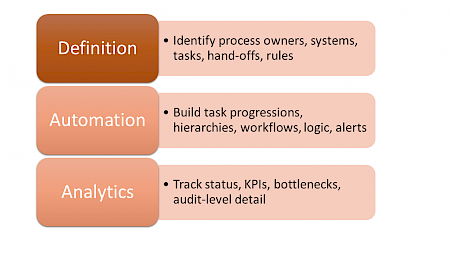What is BPMS for Your Business?
BPMS software provides business efficiency, compliance, and improved productivity.

What is BPMS?
BPMS is "Business Process Management Software" or "Business Process Management Suite." In either case, BPMS (or, more recently, iBMPS with the "i" referring to "intelligent") is a software tool used to improve an organization's business processes through the definition, automation, and analysis of business processes. Often, this is referred to as "digital transformation" to signal a migration to digital, web-based tools.
BPM Software Suites reduce manual processes and administrative tasks and help organizations achieve their goals more efficiently and efficiently. This can be done using task automation, automated tracking and reporting, and analytics. Additionally, BPM tools can help organizations increase visibility into their operations and create a more automated process for managing and tracking tasks.
We'll break down each of these concepts below. By itself, BPM is a discipline organizations use to identify, document, and improve their business processes. BPM automation software is used to enable aspects of BPM.
Familiar with BPMS and looking for a solution?
Get a private, obligation-free demonstration of Integrify and see how quickly you can automate your critical business processes.
 BPMS Elements in Detail
BPMS Elements in Detail
Definition
Before your business can create automated BPM workflow, processes must be documented, requiring planning, collaboration, and drag-and-drop tools to illustrate how complex processes look. Business process models can be created within BPMS in various ways and then reviewed by stakeholders to ensure an accurate depiction of the process. Process designs can be published in various ways or exported into different formats, commonly BPMN. Some process modelers also include simulation modes to test different process scenarios.
Automation
The primary aspect of process automation is offloading much of the rote work and task management involved in employees' day-to-day functions to a BPM solution programmed with business rules and automated triggers with limited human interaction thanks to a workflow engine. Building this automation involves assembling tasks or actions and input mechanisms (e.g., forms or system inputs) using visual workflows to mimic the behavior of a business process. The same techniques are used to automate and manage specific projects and ongoing tasks.
Analytics
BPMS tools provide various historical and real-time reporting levels or integrate with reporting tools to provide analytics about process performance. Reports are tied to KPIs (key performance indicators) and provide data on the performance of individual actions, processes, process members, etc. Analytics can identify bottlenecks and provide opportunities for continuous process improvement. In addition, audits can be run on historical actions. In addition, data from a BPMS can be pushed into Business Intelligence (BI) tools for further analysis and reporting.
Video: What is Process Management?
Business Process KPIs and Metrics
Like any business effort, measurement with BPM automation is critical. The most important thing to avoid when deciding what to measure is taking an unscripted approach that catalogs a wish list of KPIs from departmental managers since this approach may result in too long a list of KPIs to manage, KPIs that provide low business value, KPIs that are not aligned with high-level business goals, and KPIs that are actually at crossed purposes.
 Using SMART Metrics to Measure Business Process Performance
Using SMART Metrics to Measure Business Process Performance
The well-worn concept of SMART metrics applies when measuring the performance of process improvement efforts.
- Specific: Metrics should be specific and tied to business goals.
- Measurable: Metrics should be meaningful and measurable. The underlying data elements must be captured accurately and completely, and the calculation must be correct.
- Attainable: The target values for your metric must be realistically achievable. Do the right people have the ability and authority to drive the metric toward the target value?
- Relevant: Metrics should be realistic, relevant, and results-oriented. Are there identified actions that can drive the metric toward its target value?
- Time-Bound: Metrics must be timely, especially if they are leading indicator metrics. Can reports be generated, or dashboards be updated in time to allow appropriate interventions to drive the metric toward its goal?
Check out our fact-filled free BPM Guide
The BPMS Market
The vast BPMS market includes vendors that provide complete all-in-one solutions or "BPM Suites" and smaller players that provide individual aspects for definition, automation, and analytics, as well as form building, collaboration, and BPM project management. Cloud-based BPM Workflow Software Suites can be used for massive, organization-wide BPM initiatives with large teams and long, complex projects. Workflow and BPM automation software can tackle smaller, specific projects that may not require process simulation or organization-wide process modeling collaboration.
BPMS software vendors include:
- Appian
- AuraPortal
- Bizagi
- Genpact (PNMsoft)
- IBM
- Integrify
- K2
- Pegasystems
Find out more about our BPM Software and how it can help your organization drastically improve your business process management.
Finding the Right BPM Software for Your Business
Choosing the right BPM software vendor is a crucial decision for any business. Before deciding, businesses should research the available vendors, such as those that provide complete all-in-one solutions or "BPM Suites," and individual aspects, such as form building, collaboration, and BPM project management. Additionally, businesses should consider the size and complexity of their project and if they need process simulation or organization-wide process modeling collaboration.
When selecting a BPM software vendor, businesses should assess the vendor's capabilities, such as automating workflows, streamlining processes, and optimizing business operations. Additionally, businesses should evaluate the vendor's customer service, pricing, and scalability to ensure they select the right BPM software solution. Finally, it is crucial to consider the vendor's ability to provide training and support to ensure the business can make the most out of its BPM software.
For instance, Integrify provides new customers with a hands-on Customer Success team to ensure you get up and running with an intelligent process strategy and usable workflows within just a few weeks in most cases. Other vendors might provide a login and a link to their Help site.
Quick Reference: Choosing a BPMS Vendor
Factor |
Consideration |
|
Integration |
Is there a need to integrate with a single system, multiple systems, or a homegrown solution? |
|
Implementation |
How long does a typical implementation take, and will it be led by the vendor or an internal team? |
|
Ease of Use |
Can business users administer and update the system, or is development/IT needed? |
|
Platforms |
Is the system available in the cloud, on-premise, or self-managed? |
|
Flexibility |
How flexible is the solution for customization, for instance, using additional code, changing the configuration, or getting “under the hood?” |
|
Pricing/Licensing |
Is the pricing based on users, processes, transactions, fixed, or concurrency? |
|
Scope |
Is this a solution for one department, multiple departments, or organization-wide? |
|
Task Management |
Does the system provide robust tools for users when viewing and managing tasks or tracking progress? |
|
File/Document Handling |
Can the system include files and documents as part of the process and store them securely? |
|
Number of Processes |
Will there be a few complex processes, many simple processes, or a combination of these? |
|
Number if Subprocesses |
Will processes require multiple subprocesses (“Child Processes”) to meet requirements? |
|
Use of Business Rules |
Will the processes and any associated forms require simple or complex business rules? |
Considering a BPMS Solution for your department or business?
We have a library of resources that will help you in your research:



